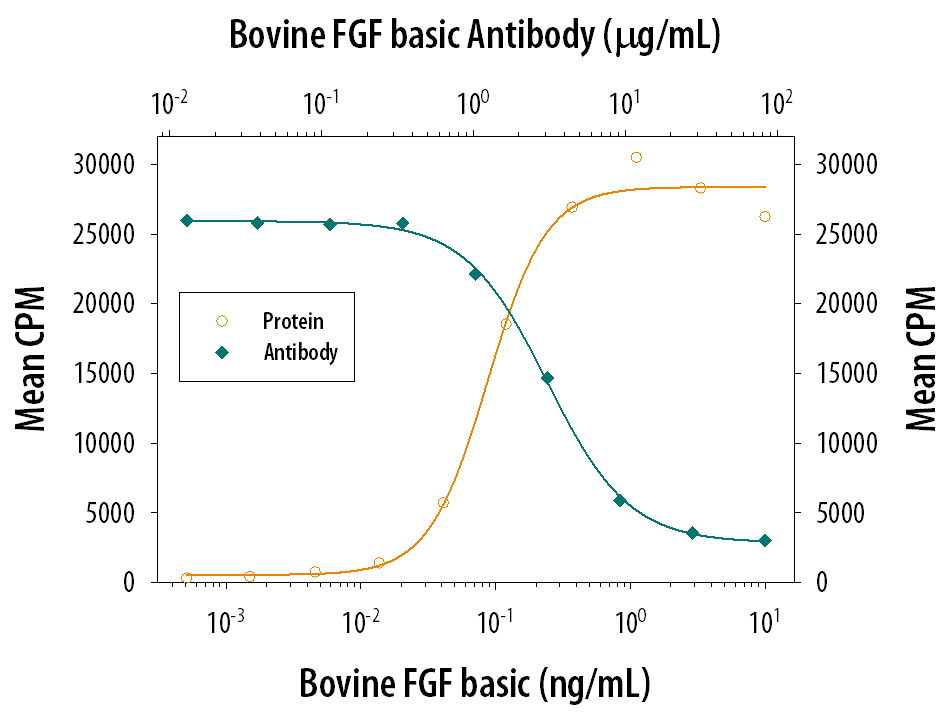Bovine FGF basic/FGF2/bFGF Antibody
R&D Systems, part of Bio-Techne | Catalog # AB-33-NA

Key Product Details
Species Reactivity
Validated:
Cited:
Applications
Validated:
Cited:
Label
Antibody Source
Product Specifications
Immunogen
Specificity
Clonality
Host
Isotype
Endotoxin Level
Scientific Data Images for Bovine FGF basic/FGF2/bFGF Antibody
Cell Proliferation Induced by FGF basic/FGF2/bFGF and Neutralization by Bovine FGF basic/FGF2/bFGF Antibody.
Bovine FGF basic/FGF2/bFGF (Catalog # 133-FB) stimulates proliferation in the NR6R-3T3 mouse fibroblast cell line in a dose-dependent manner (orange line). Proliferation elicited by Bovine FGF basic/FGF2/bFGF/bFGF (0.5 ng/mL) is neutralized (green line) by increasing concentrations of Rabbit Anti-Bovine FGF basic/FGF2/bFGF Polyclonal Antibody (Catalog # AB-33-NA). The ND50 is typically 1.5-4.5 µg/mL.Applications for Bovine FGF basic/FGF2/bFGF Antibody
Western Blot
Sample: Bovine FGF basic/FGF2/bFGF (Catalog # 133-FB)
Neutralization
Formulation, Preparation, and Storage
Purification
Reconstitution
Formulation
Shipping
Stability & Storage
- 12 months from date of receipt, -20 to -70 °C as supplied.
- 1 month, 2 to 8 °C under sterile conditions after reconstitution.
- 6 months, -20 to -70 °C under sterile conditions after reconstitution.
Background: FGF basic/FGF2/bFGF
FGF basic is a member of the FGF family, currently comprised of seven related mitogenic proteins which show 35‑55% amino acid conservation. FGF acidic and basic, unlike the other members of the family, lack signal peptides and are apparently secreted by mechanisms other than the classical protein secretion pathway. FGF basic has been isolated from a number of sources, including neural tissue, pituitary, adrenal cortex, corpus luteum and placenta. This factor contains four cysteine residues but reduced FGF basic retains full biological activity, indicating that disulfide bonds are not required for this activity. Several reports indicate that a variety of forms of FGF basic are produced as a result of N-terminal extensions. These extensions apparently affect localization of FGF basic in cellular compartments but do not affect biological activity. Studies indicate that binding of FGF to heparin or cell surface heparan sulfate proteoglycans is necessary for binding of FGF to high affinity FGF receptors. FGF acidic and basic appear to bind to the same high affinity receptors and show a similar range of biological activities.
FGF basic stimulates the proliferation of all cells of mesodermal origin, and many cells of neuroectodermal, ectodermal and endodermal origin. The cells include fibroblasts, endothelial cells, astrocytes, oligodendrocytes, neuroblasts, keratinocytes, osteoblasts, smooth muscle cells, and melanocytes. FGF basic is chemotactic and mitogenic for endothelial cells in vitro. FGF basic induces neuron differentiation, survival and regeneration. FGF basic has also been shown to be crucial in modulating embryonic development and differentiation. These observed in vitro functions of FGF basic suggest FGF basic may play a role in vivo in the modulation of such normal processes as angiogenesis, wound healing and tissue repair, embryonic development and differentiation, and neuronal function and neural degeneration. Additionally, FGF basic may participate in the production of a variety of pathological conditions resulting from excessive cell proliferation and excessive angiogenesis.
Long Name
Alternate Names
Gene Symbol
Additional FGF basic/FGF2/bFGF Products
Product Documents for Bovine FGF basic/FGF2/bFGF Antibody
Product Specific Notices for Bovine FGF basic/FGF2/bFGF Antibody
For research use only
